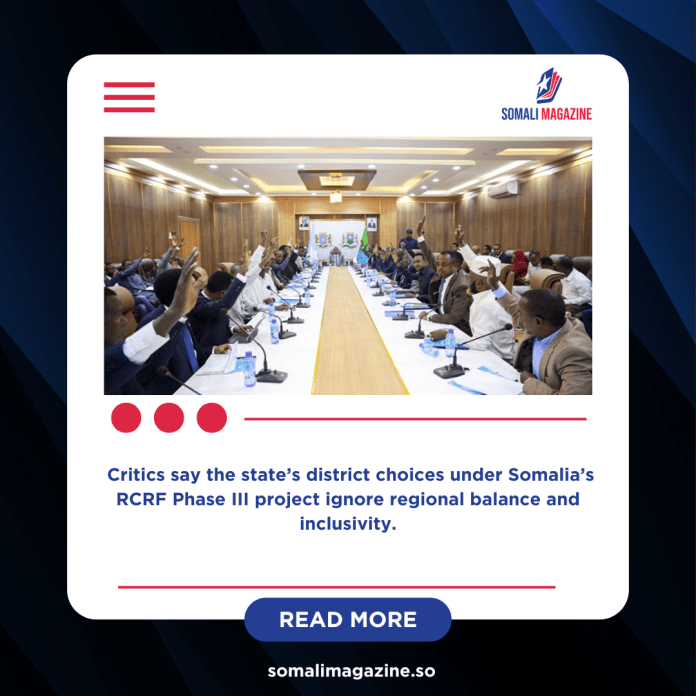Facebook Twitter (X) Instagram Somali Magazine - People's Magazine
The implementation of the Somalia Recurrent Cost & Reform Financing (RCRF) Phase III project in Hirshabelle State has stirred criticism over claims of unfair district selection and lack of regional inclusivity. The program, led by the Federal Ministry of Finance and funded by international partners, aims to support governance, strengthen local government services, and promote fair development across Somalia’s federal member states. However, concerns have emerged that Hirshabelle’s choices for the project’s participating districts failed to reflect the diversity and balance that the initiative is meant to encourage.
The RCRF Phase III project distributes funds to district administrations in two stages, known as the First and Second Cohorts. While other states have shown regional and clan diversity in their selections, Hirshabelle’s choices have been criticized for favoring one region and one community. The state first selected Warsheikh in the First Cohort and later chose Bal’ad in the Second Cohort—both located in the Middle Shabelle region and representing the same clan group. Critics argue that this decision contradicts the project’s goal of promoting fairness and inclusion in governance and development.
In comparison, other federal member states have taken a more balanced approach. For example, Southwest State chose Wajid and Barawe, two districts from different regions and clans. Jubaland selected Dhobley and Dolow, while Galmudug went with Abduwak and Adado—districts that, although in the same region, come from different clan backgrounds. Hirshabelle, on the other hand, stands out as the only state that repeated both the region and the clan in its selections, sparking debate among analysts and community leaders.
Many observers believe that the decision disadvantaged the Hiiraan region, which forms the other half of Hirshabelle State alongside Middle Shabelle. They argue that Beledweyne, a major district in Hiiraan, would have been a more inclusive choice. “Other states ensured diversity either by changing the region or selecting districts from different communities. Hirshabelle’s case stands out as an exception,” said one observer familiar with the project’s selection process.
The controversy has prompted calls for a review of Hirshabelle’s district selections. Stakeholders are urging the state’s Ministry of Interior and the RCRF coordination team to reassess their choices to align with the national standards of fairness and inclusivity that guide the project. Such a review, they say, would help restore trust among communities and ensure that development efforts under RCRF are fairly distributed across all regions of Hirshabelle.
The RCRF Phase III project, officially registered as Project ID: P173731, is now in its final year of implementation. Its completion date has been extended to December 31, 2025, to allow for the finishing of key reforms and programs. These include improving financial management systems, enhancing intergovernmental fiscal transfers, and supporting essential services in sectors like health and education.
As the project moves toward its conclusion, stakeholders emphasize the need for transparency and inclusivity to maintain credibility and achieve lasting results. Ensuring that all regions and communities feel represented in development initiatives, they say, is not just a matter of fairness—it is essential for building stronger governance and fostering unity within Somalia’s federal system.

